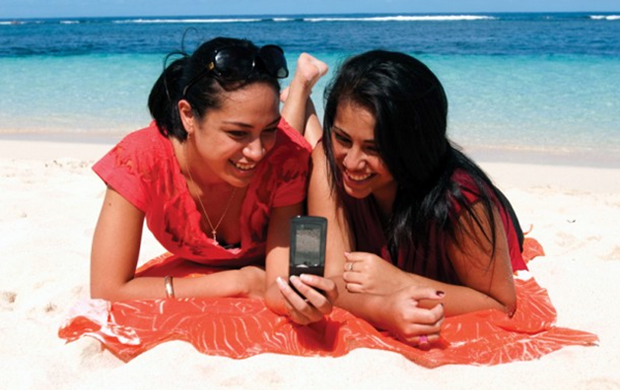
APIA (Pacific Media Watch / Samoa Observer): A government project has led to dramatically increased access to mobile phones and lower call costs for the Samoan people, as well as improvements to the postal system, according to the Samoa Observer.
Samoans have gained vastly enhanced access to phone and mail services, attributable to the Telecommunications and Postal Sector Reform Project that helped to support more effective regulation and institutions, increase competition and investment in both the postal and telecommunications sectors, and reduce call costs.
The project was financed by an International Development Association credit of US$4.48 million and US$1.85 million from the government of Samoa. Approximately 165,500 people gained access to a mobile phone from 2002 to 2010—some 90 percent of the population.
High call prices had put basic telecommunications services out of reach for most Samoans. This lack of access increased the cost of doing business and added to economic isolation within the country.
Other constraints included:
1) Poor phone coverage and access to networks. At the time the project became effective in 2003, fixed-line penetration was just 6.5 per 100 inhabitants (compared to an average of 12 for countries of a comparable wealth level), while mobile phone penetration was just 1.7 percent.
2) Inadequate postal service. Collection and delivery of post by the previous operator of postal services, SamoaTel, was limited, and below Universal Postal Union standards. Samoa lacked home and business delivery.
3) Ineffective sector regulation. SamoaTel’s self-regulation of the industry restricted sector development and interconnection agreements were limited. This situation affected the mobile phone provider’s capacity to deploy a network capable of reaching across the nation.
Solution reforms
Like many Pacific Island countries, Samoa faces challenges from geographic and economic remoteness, including unusually high transaction costs for governments and businesses.
Reforming the telecommunications and postal sectors was crucial in helping Samoa overcome these limitations, and has made a big impact on people's lives.
The Samoa Telecommunications and Postal Reform Project played a critical role in making this happen by:
1) Helping the government introduce a more competitive telecommunications sector that would reduce costs and build usage, including in remote rural areas.
2) Supporting vital reforms to the debt-ridden SamoaTel to improve management operations, including the separation of telecommunications and postal business units.
3) Samoans wanting to use phones, the internet or postal services for business or social purposes stood to benefit directly from a reduction in costs, and an improvement in services and reliability.
Around the world, increased competition in the telecommunications sector has helped expand networks and reduce usage costs.
Lower costs
In Samoa, more mobile phone operating licences resulted in lower call costs, and a more reliable and better service. This development led to a significant increase in phone use, with 165,500 people gaining access to mobile phones between 2002 and 2010.
The growth of mobile phone subscribers can be attributed to a network that expanded to rural areas previously not connected, and to the decline in call costs.
Furthermore, the Samoa Observer lists these developments initiated by the government-run project as significant milestones in the Samoan telecommunications infrastructure:
1) A second digital phone license opened in 2006.
2) Total customers (fixed and mobile) climbed from 12,500 in 2002 to 152,800 by 2008 and then 168,000 by 2010.
3) The internet subscription target was met in 2010, when the number of subscribers increased from 3,000 in 2002 to an estimated 12,000.
4) The 2010 target for an increase in the number of telecommunications customers in rural areas was 7,000. The actual number reported of customers in rural areas that year was an estimated 57,943.
5) SamoaPost is now self-sustaining and saw revenues increase from about WST 1 million (NZ$0.53 million) in 2003 to WST 2.5 million (NZ$1.34 million) in 2010.
6) The number of sub-post offices jumped from 30 in 2002 to 41 in 2010 (37 on the island of Upolu and four on Savai’i).
Moving Forward
The next challenge for the sector will be to improve broadband connectivity. This connectivity will boost opportunities for Samoans to participate in and benefit from the global economy, services, and information.
Other countries in the region want to replicate the success of the Samoan experience.
A Pacific Regional ICT Regulatory Resource Centre was established as a result of the ICT development in the region. The centre is intended to assist Pacific member countries to build their policy and regulatory capacity and to adopt best practice principles and supporting legislation.
A Pacific Regional Connectivity programme has also been established to link the Pacific to broadband internet. It was launched in Tonga on May 17, according to the website Matangi Tonga.
Having access to high-speed internet connections, as well as modern and affordable mobile phone services, means that businesses, governments, teachers, doctors, farmers, and fishermen are better able to communicate, share information, buy goods, find better prices, make payments, and improve the reach of their services.
“Everyone knows that the biggest benefit to come is affordability, especially to communicate with relatives and friends and for businesses. It used to be that everything was faxed, especially internationally because call costs were so expensive. Now it’s either emailed or you can call to confirm bookings,” says Charlotte Brunt, owner and manager of Orator Hotel.
This work is licensed under a Creative Commons Attribution-NonCommercial 3.0 New Zealand Licence.




